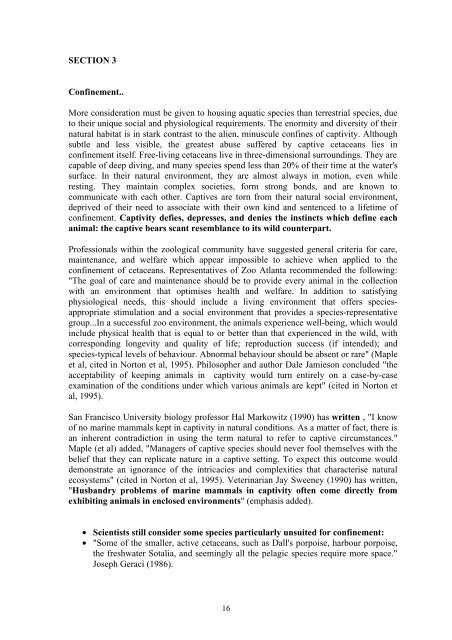Captive Cetaceans: A Handbook for Campaigners - Whale and ...
Captive Cetaceans: A Handbook for Campaigners - Whale and ...
Captive Cetaceans: A Handbook for Campaigners - Whale and ...
Create successful ePaper yourself
Turn your PDF publications into a flip-book with our unique Google optimized e-Paper software.
SECTION 3<br />
Confinement..<br />
More consideration must be given to housing aquatic species than terrestrial species, due<br />
to their unique social <strong>and</strong> physiological requirements. The enormity <strong>and</strong> diversity of their<br />
natural habitat is in stark contrast to the alien, minuscule confines of captivity. Although<br />
subtle <strong>and</strong> less visible, the greatest abuse suffered by captive cetaceans lies in<br />
confinement itself. Free-living cetaceans live in three-dimensional surroundings. They are<br />
capable of deep diving, <strong>and</strong> many species spend less than 20% of their time at the water's<br />
surface. In their natural environment, they are almost always in motion, even while<br />
resting. They maintain complex societies, <strong>for</strong>m strong bonds, <strong>and</strong> are known to<br />
communicate with each other. <strong>Captive</strong>s are torn from their natural social environment,<br />
deprived of their need to associate with their own kind <strong>and</strong> sentenced to a lifetime of<br />
confinement. Captivity defies, depresses, <strong>and</strong> denies the instincts which define each<br />
animal: the captive bears scant resemblance to its wild counterpart.<br />
Professionals within the zoological community have suggested general criteria <strong>for</strong> care,<br />
maintenance, <strong>and</strong> welfare which appear impossible to achieve when applied to the<br />
confinement of cetaceans. Representatives of Zoo Atlanta recommended the following:<br />
"The goal of care <strong>and</strong> maintenance should be to provide every animal in the collection<br />
with an environment that optimises health <strong>and</strong> welfare. In addition to satisfying<br />
physiological needs, this should include a living environment that offers speciesappropriate<br />
stimulation <strong>and</strong> a social environment that provides a species-representative<br />
group...In a successful zoo environment, the animals experience well-being, which would<br />
include physical health that is equal to or better than that experienced in the wild, with<br />
corresponding longevity <strong>and</strong> quality of life; reproduction success (if intended); <strong>and</strong><br />
species-typical levels of behaviour. Abnormal behaviour should be absent or rare" (Maple<br />
et al, cited in Norton et al, 1995). Philosopher <strong>and</strong> author Dale Jamieson concluded "the<br />
acceptability of keeping animals in captivity would turn entirely on a case-by-case<br />
examination of the conditions under which various animals are kept" (cited in Norton et<br />
al, 1995).<br />
San Francisco University biology professor Hal Markowitz (1990) has written , "I know<br />
of no marine mammals kept in captivity in natural conditions. As a matter of fact, there is<br />
an inherent contradiction in using the term natural to refer to captive circumstances."<br />
Maple (et al) added, "Managers of captive species should never fool themselves with the<br />
belief that they can replicate nature in a captive setting. To expect this outcome would<br />
demonstrate an ignorance of the intricacies <strong>and</strong> complexities that characterise natural<br />
ecosystems" (cited in Norton et al, 1995). Veterinarian Jay Sweeney (1990) has written,<br />
"Husb<strong>and</strong>ry problems of marine mammals in captivity often come directly from<br />
exhibiting animals in enclosed environments" (emphasis added).<br />
• Scientists still consider some species particularly unsuited <strong>for</strong> confinement:<br />
• "Some of the smaller, active cetaceans, such as Dall's porpoise, harbour porpoise,<br />
the freshwater Sotalia, <strong>and</strong> seemingly all the pelagic species require more space."<br />
Joseph Geraci (1986).<br />
16

















